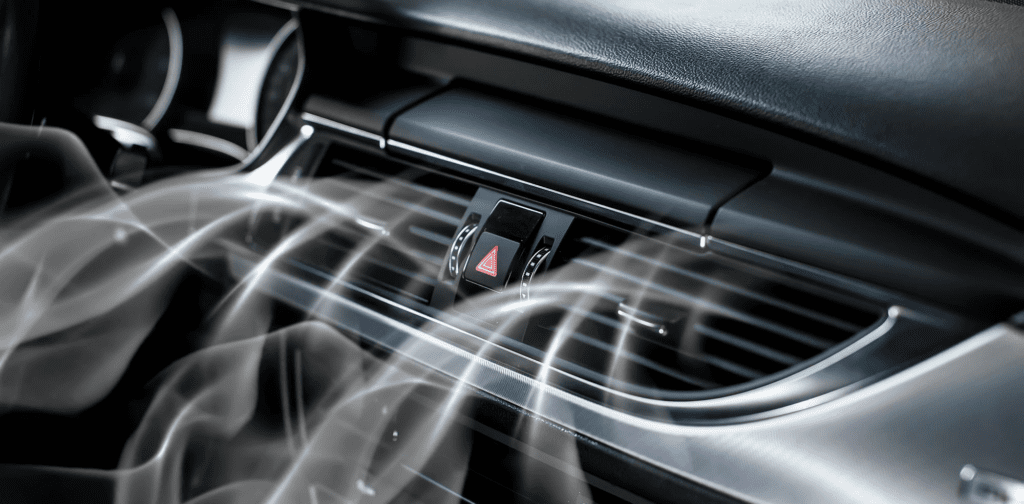Compare cheap car insurance
✔ Compare cheap car insurance quotes
✔ Over 110 insurance providers
✔ Get a quote in minutes
✔ Save up to £504*


Dealing with moisture build-up and condensation within your car? Our comprehensive guide provides you with essential insights.
- What causes condensation in my car?
- How to stop condensation in my car?
- Dealing with condensation on car windows
- How to dehumidify a car and remove damp
- How to get rid of mould in your car
- Does having damp in my car affect my insurance?
- Frequently asked questions
You’ll discover the potential culprits, effective removal methods, and proactive measures to stop its recurrence.
What causes condensation in my car?
Condensation in your car takes place due to the interaction between the warm air inside your vehicle and the cooler glass surfaces on the exterior. This collision of temperatures results in the conversion of moisture vapour into visible droplets.


Moreover, steam plays a contributing role in causing condensation within cars. For instance, if damp items are inside your vehicle and the sun’s rays heat up the interior, the resultant steam rises and settles on various surfaces as moisture.
Diverse factors can introduce elevated moisture levels into your car, increasing condensation likelihood. These factors include:
- The exhaled breath of passengers, especially in cold weather conditions.
- Presence of wet items such as coats, clothing, shoes, and umbrellas.
- Incidents of leaks from doors, windows, the sunroof, or vents.
- Emission of steam from hot beverages and food items.
- Possible coolant leaks within the vehicle’s systems.
To mitigate condensation, addressing these moisture sources and ensuring proper ventilation within the car’s interior is essential.
How much can you save on your car insurance?
How to stop condensation in my car?
Encountering condensation inside your car during your drives is quite common, but using a few straightforward measures can help you effectively combat the intrusion of moisture into your vehicle’s interior.
Keep Dampness Away
As you wrap up your day and park your car, ensure that you take along any damp items. This might include items like your umbrella, raincoat, gym attire, or even a wet dog blanket.
All these seemingly innocuous damp elements can contribute to elevated humidity levels within your car, setting the stage for condensation to occur.
Manage Steam from Food and Drinks
While it might be convenient to consume food or beverages in your car, be mindful of the steam generated. The steam from your morning coffee or lunchtime snack can significantly increase the humidity levels within your vehicle.
If it’s not feasible to have your windows open while you consume these items, consider turning on your air conditioning to help eliminate the excess moisture. Promptly disposing of any waste is also important.
Night time Protection
If you store your car in a garage, using a lightweight, breathable cover can serve as a shield against condensation formation when your car is parked. In case the condensation problem is more serious, using a dehumidifier or a low-powered heater can effectively maintain dry air inside your vehicle.
For extended periods of car storage, remember to take your vehicle for a drive occasionally to ensure optimal functioning and prevent battery depletion.
Proper Ventilation
A simple yet effective strategy involves keeping your windows slightly open on warm days and closing them on rainy ones. During colder months, even with the heating on, you can turn on your air conditioning.


The air conditioning system draws air from within the car, which passes through an evaporator, causing moisture to condense and be expelled outside.
Maintain Clean Windows
Condensation tends to cling to dirt and grime. Keeping the interior surface of your windows, especially the windscreen, impeccably clean can deter condensation from forming overnight.
Address Leaks
If you consistently notice significant moisture accumulation in your car, there could be an underlying leak issue. Inspect door seals, the boot, and the sunroof for potential leaks that might allow rainwater to infiltrate and create damp spots.
Another common source of leaks is the heater matrix, which transfers heat from the car’s cooling system to the interior. Consulting a professional can help diagnose and rectify these issues effectively.
By following these steps, you can effectively manage and prevent condensation inside your car, ensuring a comfortable and moisture-free driving experience.
How much can you save on your car insurance?
Dealing with condensation on car windows
Encountering a fogged-up windscreen and other mist-covered windows in the morning can be quite an inconvenience.
Ensuring you eliminate condensation before hitting the road is paramount – not only for your safety but also to comply with legal requirements.
Follow these steps to effectively clear condensation from your windscreen and windows and ensure a safe driving experience:
Initial Heating: Begin by switching on your car’s heater. However, set it to a cooler temperature initially. If your vehicle offers a dedicated windscreen defrost option, opt for it. This helps in gradually warming up the interior while preventing rapid temperature changes that could lead to further condensation.
Air Circulation: Activate your car’s air conditioning system to encourage air circulation within the vehicle. If your car lacks air conditioning, opening the windows can serve a similar purpose by allowing fresh air to flow through.
Incremental Heating: As the interior air temperature begins to rise and the condensation starts to dissipate, you can gradually increase the heater setting. This controlled increase in temperature aids in clearing the condensation without creating an abrupt shift that might lead to renewed fogging.
Heater and Demister: Many cars are equipped with windscreen and rear window heaters or demisters. If your vehicle offers these features, activate them to expedite the condensation-clearing process. These systems work to raise the temperature of the glass, accelerating the dissipation of moisture.
Wipers and Ventilation: While your windshield wipers might not directly clear condensation, ensuring they are operational and in good condition can help maintain visibility in case of rain. Additionally, keep the ventilation system running to maintain a consistent flow of fresh air throughout the interior.
Remember that the effectiveness of these steps might vary depending on the severity of the condensation and the specific features of your vehicle.
Regular maintenance of your car’s heating, air conditioning, and ventilation systems is crucial to ensure they function optimally when needed.
How much can you save on your car insurance?
How to dehumidify a car and remove damp
If your car’s interior has accumulated a noticeable amount of moisture, it’s essential to take proactive measures to ensure you prevent future issues related to condensation and mould.
Here are comprehensive guidelines to successfully dehumidify your car:
Ventilation is Key
One of the most effective ways to eliminate dampness and thwart mould growth is by allowing ample ventilation. On a dry day devoid of rain, make it a point to open your car’s windows and doors for an extended period.
This practice facilitates the exchange of air, aiding in the removal of excess moisture. However, exercise caution and avoid leaving your vehicle unattended during this process to ensure security.
Manage Moisture While Driving
If you encounter moisture accumulation while driving, swiftly address the issue by cracking a window open if the weather is dry. Alternatively, if it’s raining, engage the air conditioning system.
This approach helps maintain optimal humidity levels within the car’s interior, mitigating the chances of condensation forming on windows.
Combat Surface Dampness
Take a hands-on approach to eliminate excess moisture from various surfaces within your car. Use a dry cloth to wipe down any areas where moisture has collected.
For upholstery and particularly damp spots, using a fan or a hairdryer on a low-heat setting can expedite the drying process. Be cautious not to use high heat settings that might damage delicate materials.
Utilise Desiccants
Desiccants are materials that are highly effective at absorbing moisture from the air. Placing silica gel packets or other desiccant products inside your car can help reduce humidity levels. Remember to periodically replace or regenerate these desiccants as they reach their moisture-absorbing capacity.
Consider Dehumidifying Products
Various products, such as moisture absorbers and dehumidifying bags, are specifically designed to tackle excess moisture in confined spaces like car interiors. These products often feature moisture-absorbing compounds that can help maintain a dry environment within your vehicle.
Regular Cleaning and Maintenance
Regularly clean your car’s interior, paying special attention to areas prone to moisture buildup, such as floor mats and carpets. Keeping your car clean helps prevent dirt and grime from retaining moisture, which can contribute to dampness.
By following these comprehensive steps, you can effectively dehumidify your car, curbing the development of condensation and mould.
Maintaining a dry and well-ventilated interior not only preserves the condition of your vehicle but also ensures a comfortable and healthier driving environment.
How much can you save on your car insurance?
How to get rid of mould in your car
Tackling mould in your car might not be the most enjoyable task, but it’s an essential one. Beyond its unpleasant appearance and odour, mould can indeed pose health risks.
However, with some common household items and a bit of effort, you can effectively rid your car of mould without requiring specialised tools.
Consider wearing rubber gloves and a mask during the process to safeguard yourself from inhaling any mould spores you might disturb. Here’s a comprehensive approach to address the issue:
Clear the Space
Start by thoroughly cleaning your car’s interior. Remove all clutter and items from inside, discarding anything that’s already infested with mould.
Vacuum Effectively
Use a vacuum cleaner to meticulously clean carpets, car seats, and other upholstered surfaces. This step aids in eliminating any loose mould spores.
Vinegar Solution
Create a solution by mixing distilled white vinegar and water in a spray bottle. Opt for a ratio of eight parts vinegar to two parts water. White vinegar is renowned for its mould-removing properties and can act as a deterrent against future growth.
Alternatively, you can buy a specialised cleaning product formulated for mould removal.
Apply Vinegar Solution
Thoroughly spray the vinegar solution onto mouldy surfaces and upholstery. Ensure thorough saturation, using a scrub brush to work the solution into the affected areas.
It’s prudent to test a small amount of the solution on a hidden area to ensure compatibility.
Airing Out the Vehicle
Allow your car to air out, aiding in dissipating the vinegar odour. Once the treated areas are dry, you can sprinkle baking soda onto them. After a brief period, vacuum up the baking soda.
Understanding Mould Causes
Mould thrives in environments characterised by dampness and poor air circulation. To stave off future mould growth, refer to our earlier suggestions on preventing condensation and dehumidifying your car.
Addressing Underlying Issues
If a larger concern like a leak is contributing to the dampness in your car, rectifying the source of the leak becomes paramount. This preventive measure ensures that the mould problem won’t resurface in the future.
By methodically following these steps, you can effectively banish mould from your car, ensuring a more pleasant driving experience while safeguarding your health.
Remember that regular maintenance and consistent efforts to keep your car’s interior dry and well-ventilated are crucial for preventing mould growth in the long term.
How much can you save on your car insurance?
Does having damp in my car affect my insurance?
The presence of dampness in your car can potentially have repercussions on your insurance cover. If your vehicle’s condition is compromised due to issues like leaks, mould, and water damage, it might not be considered roadworthy.
This situation can lead to the nullification of your insurance policy and subsequently expose you to the risk of incurring substantial expenses for repairs.
Insurance providers often have specific criteria for a vehicle to be considered roadworthy. If your car’s dampness-related issues hinder its safe operation or structural integrity, it might not meet these requirements.
Consequently, any claims you make related to accidents or damages could be denied due to the pre-existing condition of dampness.
In addition to the financial burden of potential repairs, the invalidation of your insurance cover can result in legal consequences if you continue to drive the vehicle despite it being deemed unroadworthy.
It’s therefore important to address dampness issues promptly to ensure your car’s compliance with safety and roadworthiness standards.
To prevent these complications, regular maintenance, addressing leaks promptly, and tackling dampness-related problems as they arise are essential.
This not only preserves your insurance cover but also ensures your safety and the longevity of your vehicle.
Find out the 10 most common breakdown causes.
Frequently asked questions
The presence of moisture inside your car can stem from various factors. Here are some common reasons why your car might be wet on the inside:
Weather Incidents: Leaving a window slightly open during rainfall or having a sunroof that’s prone to leaks can introduce water into your car’s interior. Even a small opening can allow rainwater to find its way inside.
Faulty Seals: Defective door or window seals can enable rainwater to infiltrate your car. This can happen when seals have deteriorated over time or due to improper installation.
Accidental Spills: Spills from drinks, food, or even rain-soaked items can contribute to interior dampness. If not addressed promptly, these spills can seep into upholstery and carpets, fostering a humid environment.
Condensation: A significant factor in interior dampness is condensation. This occurs when warm, humid air within your car comes into contact with the cooler surfaces of windows and windshields. The result is the transformation of airborne moisture into visible water droplets.
Cabin Humidity: Excessive humidity levels within the cabin, especially in areas with frequent rain or high humidity, can lead to interior dampness. Moisture-laden air can be introduced by passengers’ breath, wet clothing, and even pets.
Ventilation Issues: Insufficient ventilation can exacerbate dampness. Limited air circulation within your car’s interior can prevent the evaporation of moisture, allowing it to accumulate over time.
Mechanical Failures: Malfunctions in the car’s air conditioning system or heating, ventilation, and air conditioning (HVAC) system can disrupt the balance of temperature and humidity, contributing to interior dampness.
Addressing these issues promptly is essential to prevent the proliferation of mould, deterioration of materials, and even electrical problems that can arise from prolonged exposure to moisture.
Regularly inspecting your car for leaks, maintaining seals, and employing measures to reduce interior humidity can help keep your car’s interior dry and comfortable.
To combat dampness in your car, you have a range of products at your disposal that can help maintain a dry and comfortable interior. Here are a couple of options worth considering:
Dehumidifiers with Silica Gel: Dehumidifying bags filled with silica gel are a popular choice. These bags are designed to be placed on your dashboard or other convenient locations within your car. Silica gel has exceptional moisture-absorbing properties, making it effective at reducing interior humidity. Once the bag becomes saturated, you can rejuvenate it by microwaving it, allowing you to reuse it multiple times.
Alternative Solutions: Some car owners have reported success with unconventional solutions. For instance, using a pair of tights filled with cat litter is a DIY approach that some people believe can help absorb moisture. While the effectiveness of this method might vary, it’s an option to explore if you’re seeking alternatives.
Specialised Car Dehumidifiers: Some manufacturers offer specialised car dehumidifiers that are designed to efficiently remove excess moisture from the interior. These devices are typically electric and use various technologies such as Peltier effect cooling or desiccant materials to achieve optimal dehumidification.
Moisture Absorbing Packs: You can find pre-packaged moisture-absorbing packs designed specifically for cars. These packs often contain a moisture-absorbing material like calcium chloride that can help reduce humidity levels in your car.
Ventilation Aids: Car air fresheners that also double as moisture absorbers are available in the market. These products often combine pleasant scents with moisture-reducing properties, helping to keep your car’s interior smelling fresh while combating dampness.
Remember that the effectiveness of these products can vary based on factors such as the severity of dampness, the size of your car’s interior, and the climate you’re in.
Regularly monitoring and addressing sources of moisture, along with using these products, can collectively contribute to maintaining a dry and comfortable car interior.










